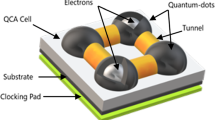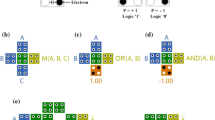Abstract
Quantum-dot cellular automata (QCA) is a novel promising nanoscale technology with high speed, low power consumption and high density that allows the design of integrated circuits. This potential merit instigated the QCA to be an appropriate alternative to the complementary metal oxide semiconductor (CMOS) technology. The arithmetic and logic unit (ALU) is considered as the basis of processing and computational units in processor systems. In this paper, we proposed a new design for reversible ALU. The significant advantages of the proposed method are low complexity, high performance, low cellular consumption, high speed and low occupation area. The proposed scheme was designed at three levels and four gates: “AND,” “OR,” “XOR” and “Full Adder.” The proposed method was simulated by QCADesigner. According to the simulated results, it reduced cell count for 28% and area for 51% in comparison with previous works.




























Similar content being viewed by others
References
Barughi YZ, Heikalabad SR (2017) A three-layer full adder/subtractor structure in quantum-dot cellular automata. Int J Theor Phys 56:2848–2858
Abdullah-Al-Shafi M, Bahar AN, Bhuiyan MMR, Shamim S, Ahmed K (2018) Average output polarization dataset for signifying the temperature influence for QCA designed reversible logic circuits. Data Br 19:42–48
Sen B, Sahu Y, Mukherjee R, Nath RK, Sikdar BK (2016) On the reliability of majority logic structure in quantum-dot cellular automata. Microelectron J 47:7–18
Tougaw PD, Lent CS (1994) Logical devices implemented using quantum cellular automata. J Appl Phys 75:1818–1825
Sasamal TN, Singh AK, Mohan A (2016) An optimal design of full adder based on 5-input majority gate in coplanar quantum-dot cellular automata. Opt Int J Light Electron Optics 127:8576–8591
Khosroshahy MB, Moaiyeri MH, Angizi S, Bagherzadeh N, Navi K (2017) Quantum-dot cellular automata circuits with reduced external fixed inputs. Microprocess Microsyst 50:154–163
Landauer R (1961) Irreversibility and heat generation in the computing process. IBM J Res Dev 5:183–191
Moore GE (1998) Cramming more components onto integrated circuits. Proc IEEE 86:82–85
Perkowski M, Jozwiak L, Kerntopf P, MishchenkoA, Al-Rabadi A, Coppola A et al (2001) A general decomposition for reversible logic. In: Proceedings of 5th International Workshop on Applications of Reed-Muller Expansion in Circuit Design. Starkville, MS, Aug. 2001, pp 119–138
Haghparast M, Navi K (2008) Design of a novel fault tolerant reversible full adder for nanotechnology based systems. World Appl Sci J 3:114–118
Babaie S, Sadoghifar A, Bahar AN (2018) Design of an efficient multilayer arithmetic logic unit in quantum-dot cellular Automata (QCA). IEEE Trans Circuits and Syst II Express Br. https://doi.org/10.1109/TCSII.2018.2873797
Heikalabad SR, Gadim MR (2018) Design of improved arithmetic logic unit in quantum-dot cellular automata. Int J Theor Phys 57:1733–1747
Gupta N, Choudhary K, Katiyal S (2013) Two bit arithmetic logic unit (ALU) in QCA. Int J Recent Trends Eng Technol 8:35
Azghadi MR, Kavehie O, Navi K (2012) A novel design for quantum-dot cellular automata cells and full adders. arXiv preprint arXiv:1204.2048
Kim K, Wu K, Karri R (2005) Towards designing robust QCA architectures in the presence of sneak noise paths. In: Proceedings of the Conference on Design, Automation and Test in Europe, vol 2, pp 1214–1219
Bahar AN, Waheed S, Hossain N, Asaduzzaman M (2018) A novel 3-input XOR function implementation in quantum dot-cellular automata with energy dissipation analysis. Alex Eng J 57:729–738
Hosseinzadeh H, Heikalabad SR (2018) A novel fault tolerant majority gate in quantum-dot cellular automata to create a revolution in design of fault tolerant nanostructures, with physical verification. Microelectronc Eng 192:52–60
Sheikhfaal S, Angizi S, Sarmadi S, Moaiyeri MH, Sayedsalehi S (2015) Designing efficient QCA logical circuits with power dissipation analysis. Microelectron J 46:462–471
Niemier MT (2000) Designing digital systems in quantum cellular automata, University of Notre Dame
Waje MG, Dakhole P (2013) Design and implementation of 4-bit arithmetic logic unit using quantum dot cellular automata. In: 2013 IEEE 3rd International Advance Computing Conference (IACC) pp 1022–1029
Ghosh B, Kumar A, Salimath AK (2013) A simple arithmetic logic unit (12 ALU) design using quantum dot cellular automata. Adv Sc Focus 1:279–284
Teja VC, Polisetti S, Kasavajjala S (2008) QCA based multiplexing of 16 arithmetic & logical subsystems-a paradigm for nano computing. In: 3rd IEEE International Conference on Nano/Micro engineered and Molecular Systems 2008. NEMS 2008, pp 758–763
Sen B, Dutta M, Goswami M, Sikdar BK (2014) Modular design of testable reversible ALU by QCA multiplexer with increase in programmability. Microelectron J 45:1522–1532
Sen B, Dutta M, Singh DK, Saran D, Sikdar BK (2012) QCA multiplexer based design of reversible ALU. In: 2012 IEEE International Conference on Circuits and Systems (ICCAS) 2012, pp 168–173
Goswami M, Sen B, Mukherjee R, Sikdar BK (2017) Design of testable adder in quantum-dot cellular automata with fault secure logic. Microelectron J 60:1–12
Gadim MR, Navimipour NJ (2018) A new three-level fault tolerance arithmetic and logic unit based on quantum dot cellular automata. Microsyst Technol 24:1–11
Naghibzadeh A, Houshmand M (2017) Design and simulation of a reversible ALU by using QCA cells with the aim of improving evaluation parameters. J Comput Electron 16:883–895
Abutaleb M (2018) Robust and efficient QCA cell-based nanostructures of elementary reversible logic gates. J Supercomput 74:6258–6274
Bahar AN, Waheed S, Uddin MA, Habib MA (2013) Double Feynman gate (F2G) in quantum-dot cellular automata (QCA). Int J Comput Sci Eng (IJCSE) 2:351–355
Heikalabad SR, Asfestani MN, Hosseinzadeh M (2018) A full adder structure without cross-wiring in quantum-dot cellular automata with energy dissipation analysis. J Supercomput 74:1994–2005
Wang L, Xie G (2018) Novel designs of full adder in quantum-dot cellular automata technology. J Supercomput 74:4798–4816
Hashemi S, Azghadi MR, Navi K (2018) Design and analysis of efficient QCA reversible adders. J Supercomput. https://doi.org/10.1007/s11227-018-2683-0
Ahmadpour S-S, Mosleh M (2018) A novel fault-tolerant multiplexer in quantum-dot cellular automata technology. J Supercomput 74:4696–4716
Walus K, Dysart TJ, Jullien GA, Budiman RA (2004) QCADesigner: a rapid design and simulation tool for quantum-dot cellular automata. IEEE Trans Nanotechnol 3:26–31
Roohi A, DeMara RF, Khoshavi N (2015) Design and evaluation of an ultra-area-efficient fault-tolerant QCA full adder. Microelectron J 46:531–542
Author information
Authors and Affiliations
Corresponding author
Additional information
Publisher's Note
Springer Nature remains neutral with regard to jurisdictional claims in published maps and institutional affiliations.
Rights and permissions
About this article
Cite this article
Oskouei, S.M., Ghaffari, A. Designing a new reversible ALU by QCA for reducing occupation area. J Supercomput 75, 5118–5144 (2019). https://doi.org/10.1007/s11227-019-02788-8
Published:
Issue Date:
DOI: https://doi.org/10.1007/s11227-019-02788-8




